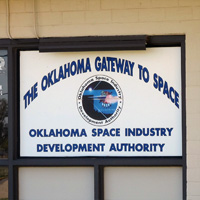
OK’s Space Mission Continues Despite Budget Cuts, a Bankruptcy and New Competition
-
Logan Layden

Logan Layden / NPR StateImpact
A U.S. Air Force plane takes off from the two-and-a-half mile runway at the Oklahoma spaceport in Burns Flat.
The Oklahoma Space Industry Development Authority was created in 1999 with the vision of Oklahoma as the national pacesetter in the emerging commercial space industry that would make space tourism a reality. Thirteen years later, the agency barely clings to life.
Move ahead to August 2008. A small experimental plane with a rocket engine takes off from Spaceport Oklahoma in Burns Flat on a test flight. After years of planning, experimental flights were finally happening at the former Air Force base re-purposed as a spaceport, but trouble was already brewing in the state’s young space industry.
A company called Rocketplane was awarded a state tax incentive worth $18 million to be the anchor tenant at the spaceport. The company planned to build a ship that would take tourists from the plains of western Oklahoma to low-earth orbit. It also won a contract with NASA to build a vehicle to send cargo to the International Space Station. It was an ambitious plan, and by the summer of 2010, Rocketplane was bankrupt.
[module align=”left” width=”half” type=”pull-quote”]
It’s tough to see a case where Oklahoma would have a competitive advantage over New Mexico or California or other places, like Florida.
-Jeff Foust of industry blog newspacejournal.com
[/module]
“I bet the ranch on space,” Rocketplane owner Geroge French Jr. said. “I went into personal bankruptcy after it was all over.”
French says the sub-prime mortgage crisis hit just as he was about to secure $500 million for a NASA funding benchmark.
“The vice president of the bank actually put his arm around me and said, ‘don’t worry, George, we’re gonna raise this money for you,”’ French said. “When Wall Street blew up, virtually everybody, including the big banks, was involved in the sub-prime loans. And so all the money in New York puckered up. Period.”
With the evaporation of the NASA deal and the economic crisis underway, Rocketplane was doomed. But the Oklahoma Space Industry Development Authority, which runs Spaceport Oklahoma, remains.
The authority has been a victim of state budget shortfalls like most other state agencies, going from an appropriation of about $1 million back in 2003 to just less than $400,000 for fiscal year 2012. OSIDA was lucky to get that. Gov. Mary Fallin backed off a plan last legislative session to eliminate the agency.

Logan Layden / NPR StateImpact
OSIDA Director Bill Khourie discusses the history of Spaceport Oklahoma, which began its life in 1942 as a Naval air station.
OSIDA Director Bill Khourie slaps the big red button that opens the massive doors of a 32,000 square-foot hanger just off the Spaceport’s two-and-a-half mile runway, one of the longest in North America.
“I don’t live in fear,” Khourie said. “Whatever the future brings it will bring, but in the meantime it’s not going to detour us, nor slow us down or take away from the intensity that we have to do the best we can to bring jobs to Oklahoma, utilizing this facility to do so.”
Currently, the primary user of the Oklahoma spaceport is the U.S. Air Force, which flies training missions there. Khourie said a name change to the Oklahoma Air and Spaceport reflects its versatility as a general aviation facility.
He said discussions continue with private spaceflight companies like Virgin Galactic and XCOR, but Oklahoma now has competition from nearly a dozen other spaceports. New Mexico just spent more than $200 million on its new Spaceport America.

Logan Layden / NPR StateImpact
A sign outside the Spaceport Oklahoma's control tower reflects the enthusiasm OSIDA officials still have for the future of OK's space industry.
“The advantage that the Oklahoma spaceport had was that it had inherited the infrastructure from the former Air Force base there,” said Jeff Foust, who runs the space industry blog newspacejournal.com. “But now that Spaceport America is pretty much complete that particular advantage has gone away. It’s tough to see a case where Oklahoma would have a competitive advantage over New Mexico or California or other places, like Florida.”
With continued slow economic growth predicted for the state, the legislature likely won’t be in the mood to restore previous funding levels this coming legislative session.
